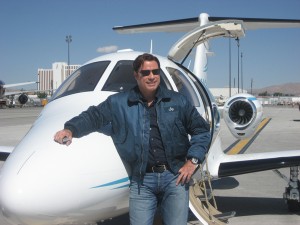
John Travolta takes in the sights at the Reno National Championship Air Races and Air Show 2007 in front of his new Eclipse 500.
By Di Freeze
When John Travolta signed on as ambassador-at-large for Qantas, he took that mission seriously. He was just as earnest when he agreed to align with Breitling. His willingness to represent someone or something he believes in with his whole heart is the reason Airport Journals has selected the superstar as the recipient of its 2008 Ambassador of Aviation award.
When it comes to aviation, Travolta is more than up to the task of serving as a messenger.
“I’m certainly genuine in my feelings about it,” he says. “I couldn’t be more authentic about my passion. It’s always allowed me distraction from the woes of life. I’ve used aviation as a beautiful expansion of the pleasures of my life. There’s not a thing about it, really, that I don’t enjoy. And I really want others to enjoy it.”
Born Feb. 18, 1954, it didn’t take long for Travolta to become intrigued with aviation. Even when he was a child, the entertainment industry and aviation merged. His mother, Helen Cecilia Burke, and sisters Ellen, Ann and Margaret were stage performers who often traveled.
“I was the baby of the family,” he said. “In the late ’50s, Ellen was off to college and then off to shows. All through the early ’60s, she was still traveling quite a bit. Whether it was her, my other sister or my mother, I would say goodbye to them at the airport. Finally, in 1962, at 8 years old, I got my own flight on a National Airlines DC-6. That was the beginning of the reality of flying for me. Up to that point, it was all observing. I just loved it.”
Every day, Travolta would wait for planes to fly over the family’s home in Englewood, N.J.
“Because of the path of LaGuardia Airport, the planes were about 2,000 feet by the time they got to my house,” he said. “I’d hear one coming, the drone of the big reciprocal engines—’brooooooom.’ I’d see it come out from a corner of the sky, and then I would sit and watch. Sometimes, I could make out the insignia of the airlines—TWA, Eastern, American or United. It was beautiful to watch them come in sight and go out of sight. A lot of Constellations left LaGuardia; 6s and 7s were popular, too. It was the height of the large propeller airliner days, and it was fascinating.”
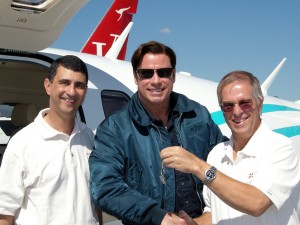
Vern Raburn (right), founder and CEO of Eclipse Aviation, accompanied by Mike McConnell (left), VP of marketing and sales hands, hands John Travolta the keys to his new Eclipse 500.
His fascination continued as different aircraft began flying overhead.
“In 1964, LaGuardia started jet service,” he said. “As they replaced the Connies and the 6s and 7s, you could see the jets start to fly over. The jets had been out five years earlier. They were flying out of Kennedy and Newark, but not so much LaGuardia. So, for a long time, the propeller age was extended for me, in observation.”
Travolta’s passion went beyond observation. His father, Salvatore Travolta, was busy raising six children, but always found time to provide help in the projects that fascinated his youngest son.
“My dad and I would turn various machines into other machines,” he said. “One time, I wanted a plane reminiscent of an airliner that I could taxi around the neighborhood. He had a board, maybe eight or 10 feet, and he made a frame for it; he was going to put metal around that. Separately, we had another board that had two car generators that turned big wooden propellers, one on each side of the wing. We never quite put the fuselage together with the plane, but it was going to be able to sit people my size—7 or 8. I had it all mocked up.”
Although the plane was still in two parts, Travolta wanted to be prepared. As captain, he would need “stewardesses,” so he recruited various female friends who eagerly donned their Brownie uniforms and makeshift footwear.
“They had Barbie high heels, so I said, ‘Just wear those; those will be fine,'” he recalled. “We never quite finished that plane; we turned it into a go-cart. But my dad did finish another plane for me; we made a single-seater propeller plane out of wood and cardboard I used to run around in.”
Real flying
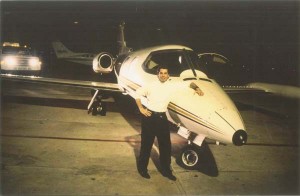
John Travolta began flying lessons in 1970. All of the money he earned from acting went toward earning his license. After collecting enough hours, he soloed at the age of 19.
When Travolta wasn’t exploring his interest in aviation, he was delving into the world in which his mother and sisters were deeply involved. His father encouraged that interest as well, setting up a mini theater in the basement where the children could perform.
At the age of 12, Travolta appeared in a local theater play, “Who’ll Save the Plowboy?” His mother nurtured his talent by enrolling him in drama school. At 16, he dropped out of Dwight Morrow High School to move to New York City, where he lived with his sister, Ann.
After appearing in various TV commercials and local summer stock productions, he landed a role in “Bye Bye Birdie,” a musical comedy, in 1970. That same year, Travolta began flying lessons. All of the money he earned from acting went toward earning his license.
“I could only afford so much at a time,” he said. “I’d take a few lessons, wait and take another few.”
Travolta moved to Hollywood to look for acting opportunities, before returning to New York when he was 18. There, he eventually won the Broadway role of “Doody” in “Grease,” a musical set in the 1950s. He subsequently performed in “Over Here,” starring the Andrews Sisters, and later went on to tour with the show. In 1972, he was cast in minor roles in the TV shows “Kids” and “Emergency.”
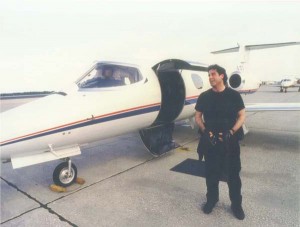
Since buying his first airplane, an Ercoupe, John Travolta has owed a Gulfstream, Lear 24, Hawker 1A, Citation I and II, Canadair Tebuan (Snowbirds) and de Havilland Vampire jets, 707, Douglas DC-3, Constellation, JetStar 731 and an Eclipse 500.
As his roles increased, so did his ability to pay for more flying lessons.
“Finally, after collecting enough hours of flying, I soloed when I was 19,” he recalled.
That solo wasn’t something he easily accomplished.
“My solo was really geared around someone’s faith in me,” he said. “I’d quit a couple of times, because I just didn’t have the confidence. My third time, my instructor was Tom Fanta, a United Airlines pilot who’d been furloughed. He cried when I quit. He said, ‘If you just stick with me a couple more hours, I promise you, it will all come together. It’s all going to make sense.’ He welled up, and I thought, ‘He means it! It matters to this guy if I solo.’ So, I did it almost for his sake, because I’d already given up. And he was right. The next couple of hours, it all came together.”
Travolta had thought he was still a few hours away from soloing when Fanta told him it was “time.”
“We were in training, and he said, ‘Guess what? You’re ready,'” Travolta remembered. I said, ‘You’re kidding.’ He said, ‘No. I think you’re absolutely ready. I’m going to get out, and I want you to go do three takeoffs and landings. I’ll see you when you get back.’ I was really touched by his enthusiasm. I did three beautiful takeoffs and landings. It was really an accomplishment. I was very proud.”
That same year, he bought an Ercoupe.
“It was a little single-engine, two-seater airplane that was advertised as ‘the plane that flew like a car,'” he said. “The rudders and the ailerons were interconnected. I loved that plane. I ended up giving it away to an older guy who I thought loved it. He needed the money more than he needed the plane, so as soon as I gave it to him, he sold it. I learned a lesson there.”
Bigger roles and bigger planes
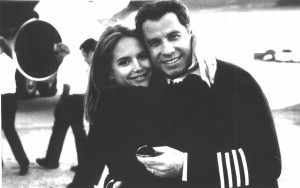
In 1987, John Travolta starred in “The Experts” alongside Kelly Preston. The chemistry between them led to marriage in 1991.
After appearing in a few other TV roles, Travolta went to Durango, Mexico, in 1975, to do a small role in his first feature film. While there, he had a life-changing experience when an actress gave Travolta a copy of the L. Ron Hubbard book “Dianetics,” introducing him to Scientology.
Travolta believes the self-help aspects of the applied religious philosophy played a major role in the success that followed. Immediately upon returning to California, he landed his breakthrough role as “Sweathog” Vinnie Barbarino on the situation comedy “Welcome Back, Kotter.” Travolta’s swaggering performance as Vinnie Barbarino, an Italian-American heartthrob, made him a standout among the strong ensemble cast. He also landed a memorable supporting role in the first adaptation of Stephen King’s “Carrie,” directed by Brian De Palma.
“Welcome Back, Kotter” ran from 1975 to 1979, coinciding with Travolta’s explosion in the public consciousness, though he did suffer a tremendous personal setback. While filming a 1976 television movie, “The Boy in the Plastic Bubble,” he fell in love with actress Diana Hyland, who died of breast cancer the following year. Travolta later accepted her Emmy, posthumously awarded for her performance in the film.
In 1977, Travolta spent nine months learning to disco dance. It paid off with his starring role as troubled Brooklyn dance king Tony Manero in “Saturday Night Fever,” a performance that earned him his first Oscar and Golden Globe nominations, vaulted him to superstardom and launched the disco phenomenon of the late 1970s.
His fame was cemented a year later when Travolta revisited “Grease,” this time as the lead Thunderbird, Danny Zuko, opposite Olivia Newton-John. It became the third-highest grossing film of the era, topped only by “Jaws” and “Star Wars,” and earned Travolta his second Golden Globe nomination.
“Grease” helped earn Travolta a successful sideline as a recording artist. His self-titled 1976 debut landed him a top 20 single, “Let Her In.” In 1977, he hit #106 on the Billboard singles chart with “Slow Dancing,” and his contributions to the “Grease” soundtrack in 1978 included “Summer Nights,” “Greased Lightnin'” and the ballad “Sandy.” A deluxe two-record set of his own recordings called “Travolta Fever” followed in 1978. Much of his musical output is still available on the 2007 compilation “Greased Lightnin’.”

On Dec. 17, 2002, Senator John Glenn (right) joined with actor and aviator John Travolta, master of ceremonies, to kick off a yearlong commemoration honoring the 100th anniversary of the Wright brothers’ first powered flight.
The actor scored another hit with his dramatic performance as cowboy Bud Davis in 1980’s “Urban Cowboy,” a film that inspired a widespread and mainstream rediscovery of country music. He also gave a memorable performance in Brian De Palma’s “Blow Out,” now considered a classic by many, and in 1983, returned as Tony Manero in the moneymaking hit, “Staying Alive.”
In 1985, Travolta’s fame was boosted even higher when Princess Diana of Wales requested him as a dance partner for a White House dinner. That same year, he starred in “Perfect,” opposite Jamie Lee Curtis.
In 1987, he starred in a comedy called “The Experts,” alongside Kelly Preston. The chemistry between them would eventually lead to a quiet wedding ceremony in Paris in 1991, followed by vows in a more formal ceremony in Daytona Beach, Florida.
In 1989, Travolta played cab driver James Ubriacco in “Look Who’s Talking.” The popular comedy/romance, which also starred Kirstie Alley, earned the People’s Choice Award for Best Picture.
The world saw a different Travolta when Quentin Tarantino reintroduced him to the public in 1994 in the smash hit “Pulp Fiction.” He was paid a bargain rate for his performance, but his riveting portrayal as hit man Vincent Vega earned him a second Oscar nomination for best actor and revitalized his career. He also received BAFTA and Golden Globe nominations for this highly acclaimed role and was named best actor by the Los Angeles Film Critics Association, among other distinguished awards. Fans were thrilled to see him once again on the dance floor in a twist contest with Uma Thurman, and were stimulated by his philosophical conversations with fellow avenger Samuel L. Jackson.
The reinvigorated actor went on to several iconic roles during the 1990s, including that of Chili Palmer, a Mafioso turned movie producer in “Get Shorty,” which garnered him a Golden Globe award. He starred in 1996’s top-grossing action thriller, “Broken Arrow,” before morphing into a man who discovers he has super-intelligence and telekinesis in “Phenomenon.” He continued the supernatural theme as an archangel in the hit comedy “Michael,” before his role alongside Nicolas Cage in John Woo’s “Face/Off” and as an undercover detective in “The General’s Daughter.”
Travolta was honored with the American Cinematheque Award in 1997, for his extraordinary career and his significant contribution to the art of film and television. The following year, the British Academy of Film and Television Arts honored him with the Britannia Award and he received the Lifetime Achievement Award at the Chicago Film Festival. He won the prestigious Alan J. Pakula Award from the US Broadcast Critics Association for his performance in 1998’s “A Civil Action,” based on the best-selling book and directed by Steve Zaillian. He was nominated again for a Golden Globe for his performance that same year as a presidential candidate in “Primary Colors,” directed by Mike Nichols and costarring Emma Thompson and Billy Bob Thornton.

On his stop at PrivatAir Le Bourget, during his “Spirit of Friendship Tour,” John Travolta was given a model of a PrivatAir BBJ.
In 2000, Travolta played an alien villain in a film adaptation of Hubbard’s science fiction epic “Battlefield Earth.” He continued to stretch his acting talents with many other roles, including that of a covert agent in “Swordfish,” a wild-living ex-Army Ranger turned DEA agent in “Basic,” an English professor in “A Love Song for Bobby Long” and a captain in “Ladder 49.” In 2005, he reprised his role as Chili Palmer in “Be Cool,” and the following year, he returned to the big screen in “Lonely Hearts” as Elmer Robinson, a New York detective intent on apprehending a pair of killers who lured their victims through the personals.
As his acting talent has grown, so has Travolta’s ability to pilot a variety of aircraft. Travolta’s qualified as captain in the Gulfstream, Lear 24, Hawker 1A, Citation I and II, Canadair Tebuan (Snowbirds) and de Havilland Vampire jets. He’s also qualified as a first officer in the Boeing 707 and 747. He’s owned all of those aircraft, except the 747.
“I flew the simulator for the 747, but I literally flew the A380,” he said. “I was the first non-test pilot to fly it. That was a thrill.”
Travolta has also owned a Douglas DC-3, a Constellation and a JetStar 731.
“I had a lot of time in the JetStar, but I never got rated in it,” he said. “I was more of a first officer in that.”
Travolta definitely feels differently flying his 707 than when he’s flying his GII.
“I’m a romantic, so I’m going to get on a 707 and feel like I’m the guy I was admiring as a child, in the masterful 707 or a big airliner,” he said. “I’m going to dramatize it—an illusion of yesteryear, of heyday. I get a bigger kick out of the 707, yet I don’t really care what plane I’m in; I love being in one.”
Besides those two aircraft, he presently owns two ultralights for sport flying. The latest addition is an Eclipse 500.
Eclipse, Breitling and Qantas
Travolta acquired his Eclipse 500 from Eclipse Aviation in mid-October.
“I’m a work in progress on that one,” he said on Oct. 30, after a long day of intensive training. “I did a week of training, then I had to go to London for business, and I had a week off from training. Yesterday, I started again. I’ll go all week, and then I’ll go out to Albuquerque to do some upset training. They take you in a different aircraft and do some aerobatic work, in case you ever get into an unusual attitude.”
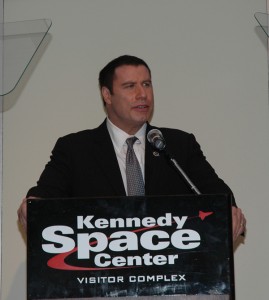
On July 15, 2005, John Travolta participated in the 30th reunion of the Apollo-Soyuz Test Project at Kennedy Space Center. The master of ceremonies of a gala that evening, Travolta gave a history of the project that united astronauts and cosmonauts.
Travolta explained how his history with Eclipse Aviation founder Vern Raburn led to his latest aircraft acquisition.
“I had a Lockheed Constellation for a couple of years, and I was very fond of it,” he said. “But with the other aircraft I owned, I didn’t have the time or the money to put into the plane, so I sold it in 1984. The buyer was Vern. I heard he was the partner of Bill Gates of Microsoft, and I thought, ‘He has the wherewithal to take good care of this plane,’ so I was very happy to sell it to him. I followed Vern and that Constellation throughout the years. He refurbished it and flew it around the world and to air shows. He had it up until a few years ago, when he sold it to a museum in Korea.”
A decade and a half after selling the Constellation to Raburn, Travolta read an article about Raburn’s involvement in a new project.
“It said he was developing a very light jet called Eclipse,” Travolta said. “I thought, ‘Wow, this is exciting. I’ll call him and find out what it’s about.’ I did and he told me that it was in the early development stages. I said, ‘One day I’ll come out and visit.'”
He visited the plant in Albuquerque, N.M., a few years later.
“They had kind of a prototype,” he said. “It looked very interesting. A year later, it was even more evolved. It looked like it was really coming to fruition, and it was getting quite a bit of attention in the aviation world.”
Travolta thought he might like to be associated with the project. He called Raburn once more and again went out to Albuquerque.
“I said, ‘Let’s try to make a proposition with each other. I did well for Breitling watches in the aviation world, and I did well for Qantas Airlines. I helped both those corporations out quite a bit. Maybe I can help you, by being a name or an icon for your aircraft,'” he recalled telling Raburn. “He said, ‘Let me think about it.’ He came back to me a couple months later and said, ‘OK, I’m ready to talk business.’ We talked and loosely negotiated a deal. It evolved over the next year and finally happened. At some point in the not too distant future, in the next year or two, I’ll do what I did for Breitling and Qantas; I’ll be an icon for Vern’s airplane, whether it be at air shows or in magazine ads—things like that.”
Travolta is impressed with the airplane.
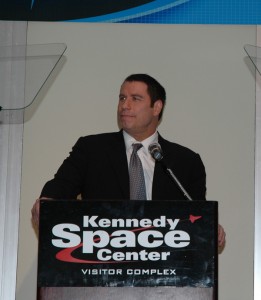
During the Apollo-Soyuz Test Project gala in 2005, John Travolta firmly acknowledged his belief in the space program.
“It’s a brilliant, genius aircraft,” he said. “It’s a very interesting cockpit, because it’s completely computerized. If you’re coming from that world, which Vern has, that’s a natural. It’s more like the Airbus industry type cockpit. It’s a glass cockpit with layers and pages of data and schematics. It takes a bit of getting used to, because it’s new age, new technology. I’m used to the analog old school stuff, so this is a challenge for me, but I’m finding it fascinating. It flies beautifully. It’s interesting; it flies like a small plane when it takes off and lands, but it flies like an airliner when it’s in the air. When it’s actually flying, it has this really solid feeling to it.”
Travolta says that his three associations with major movements in aviation are based on his passion as well as his results. In 2001, he approached Geoff Dixon, CEO and managing director of Qantas, with a proposal.
“I said, ‘I’d love to paint my airplane in your colors, because I’m desperate to have my corporate plane look like an airliner. Most people want the other, but I grew up with these planes, and I really want to see my plane the way it should be, when it used to belong to your airline.’ I said, ‘I guess I’m asking permission to paint my plane in your colors, but while we’re talking about that, maybe you’re interested in a kind of barter with me, to promote your airline,'” he recalled.
Travolta voiced his idea of being an ambassador for Qantas: he’d fly around in his 707, with Qantas insignia, promoting the airline. Dixon responded that it was an interesting, different and refreshing idea, and that he’d give it some thought. Qantas granted permission for Travolta to paint his plane in its insignia and made a proposition.
“Geoff said, ‘We’d like to request your services, promoting the airline with an around-the-world flight, in the different cities that Qantas serves,'” Travolta recalled. “We designed a trip to 13 cities in 10 countries. Basically, I would dress up in the original 1960s regalia, with a whole crew that looked the same, and we would tour the world.”
That was the plan before Sept. 11, 2001.
“When that happened, people were gun-shy about flying, so we decided that it would be much better to make it a goodwill tour,” he said. “We’d promote people getting back into the air and air safety.”
Essentially, the mission was to assure people that they could again trust the airlines.
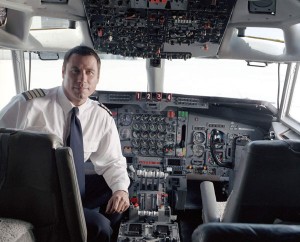
John Travolta’s qualified as captain in the Gulfstream, Lear 24, Hawker 1A, Citation 1 and 2, Canadair Tebuan (Snowbirds) and de Havilland Vampire jets. He’s also qualified as a first officer in the Boeing 707 and 747.
“I did a two-month world tour,” he said. “I believe it did make a difference. Qantas became more of a household word, and people knew that it was the number one airline in the world, as far as safety and quality of service. I helped reiterate and solidify that; in turn, they supported my aircraft.”
As a token of its appreciation, Qantas also wanted to give Travolta a 747.
“I told them I’d rather they just help me with my 707,” he said. “They were willing to do that.”
Travolta’s work with Qantas led to his relationship with Breitling.
“Breitling took notice of my work with Qantas and came to me with a proposal,” he said. “These are people at the top of their field. They want to get into business with someone who can make a difference, and they felt like I could. I did, too.”
Travolta’s willingness to be associated with projects he believes in also prompted him to narrate a 50th anniversary documentary on the Blue Angels in 1996.
Jumbolair
Travolta’s passion for aviation has inspired many people. So has his home at Jumbolair Aviation Estates, in Ocala, Fla.
“A very famous musician who’s won several Academy Awards came to my house,” he recalled. “He said, ‘You’re really making me look at aviation and airport structures as an art form. Before now, I hadn’t looked at it like that, but these gorgeous aircraft and this gorgeous house—I realize it is art.’ I guess I’ve always wanted people to enjoy the art of flying, the art of airports, the art of travel, because there is an art to it. You just have to indulge in it. Just as there’s an art to eating, to dining and to prep in restaurants, there’s an art here.”
Travolta’s home at Jumbolair, the nation’s largest and most exclusive fly-in community, reflects the influence of people who have inspired him over the years.
“Eero Saarinen, who designed the terminal at Dulles International Airport, was a big inspiration, as far as airport design,” he said. “Others are Morris Lapadis, who did a lot of hotels, and Frank Lloyd Wright,” he said. “They had an advanced viewpoint on modern architecture that lent itself to my aviation house as well.”
His house also reflects his childhood interest.
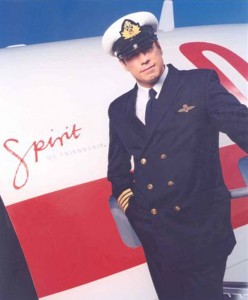
In 2001, John Travolta approached Qantas Airlines with a proposal. He wanted to paint his 707 in Qantas colors, but he also wanted to promote the airline. Qantas proposed an around-the-world flight in the different cities the airline served.
“I have a tremendous collection of airline memorabilia, from 1932 until about 1975,” he said. “I have schedules, menus, maps and paraphernalia the airlines would give for your “comfort on board.” I have silverware, plate settings for different airlines, coffee containers. It runs the gamut.”
Living at Jumbolair makes it possible for Travolta’s aircraft to be nearby. Two overhang ports at his spacious home protect his aircraft.
“The ultralights are hangared in smaller housing,” he said. “I have a proper hangar at Ocala Airport (OCF). In bad weather, I take the GII over there. I don’t quite know yet what I’m going to do with the Eclipse. I’ve been using it all the time, so I haven’t decided. I guess I could take it over there as well.”
Combining aviation with a busy career
Travolta describes aviation as an “extroverting activity” that has enhanced his career as an actor.
“You have to pay attention to what you’re doing,” he said. “Anything that’s extroverting is healthy for the mind, and anything that’s healthy for the mind is healthy for anyone, including an actor that spends a lot of time having to look introspectively. I think it’s therapeutic for anybody, but in particular, for an actor.”
On occasion, Travolta has combined his avocation with his vocation, including his role as an Air Force major piloting a stealth bomber in “Broken Arrow.”
“Whenever I play a character that flies, it’s so natural to me that I don’t worry about looking ‘real’ or believable, because I do it almost every day,” he said. “So, it’s not anything that I worry about. That helps.”
Travolta, who flies himself to locations whenever possible, would like to be in a film that depicts his passion for flying, but says also that the “definitive aviation film” is yet to be made.
“That’s my personal opinion,” he said.
It’s never easy for Travolta to integrate refresher training into his busy schedule, but he does, because of its importance.
“I’ve been doing it three times a year, for the 707, 747 and GII,” he said. “Now, with the Eclipse, it will be four. It takes five days, with my travel. I dedicate a week to each aircraft, so that’s almost a month a year, broken up or sometimes strung together. It’s always stressful, because it’s intense recurrency. They throw the book at you, and it doesn’t get easier every year; it actually gets a little harder. For example, this summer I was in the middle of a movie, and my licenses were almost overdue. I had one 10-day period off. That was my only time off in five months, but I told myself, ‘I’d better get down to Pan Am and do my 707 and to Dallas (the location of SimuFlite) and do my GII.
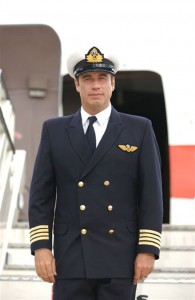
After 9/11, John Travolta’s around-the-world tour for Qantas became a goodwill tour, with the objective of getting back into the air and promoting air safety.
“Then, as soon as the movie was over, I went right into Eclipse school. It’s very time-consuming, when you have a whole other profession. But if you don’t do it, you can’t keep up the professional angle. These are very serious aircraft, not to be taken lightly. You really have to go to school, let them throw the book at you and keep fresh, because you do forget things over the year. When you’re flying three or four different planes, it’s like, ‘If it’s Tuesday, this must be Belgium.’ You’re saying, ‘Gosh, what’s the speed on this one again? Oh, yeah; all right.’ There is overlap with each plane, but still, you’re dealing with some serious stuff.”
Travolta has accumulated 5,000 hours since he began flying in 1970. In that time, he’s had only one serious incident. In 1992, while flying his Gulfstream, he experienced an electrical failure.
“One incident in 37 years isn’t bad,” he said. “That happened at Thanksgiving. I had a total electrical failure—double generator, no access to my backup alternators, and the batteries were gone. Fortunately, I had two beautiful Rolls-Royce engines still purring out there. I had to analog backup the equipment for flying. I had instruments to see how I was doing, but no communications or electric. I remembered all my training. I found a hole in the sky, made my way down through it and hovered over Washington, D.C., and then landed at (Ronald Reagan) National Airport, near the monument. That’s why you go to school and why you have to take it very seriously.
“Those are the kinds of things you practice. They throw a lot of things at you. You lose engines, hydraulic, electric, navigation; you run out of fuel; they have planes come straight at you to divert you; you have wind shear; they throw no gear coming down; you name it. You’re barraged with this onslaught of technical difficulties at school every year.”
Life happens
Travolta’s childhood passion for aviation led him to pen “Propeller One-Way Night Coach,” originally published in 1992. The book tells the story of a young boy traveling across America, from the East Coast to Los Angeles, in 1962. Travolta actually took his first flight that same year, but the story is fictitious.
“It just unfolded very beautifully in my mind one night when I was weathered in, at a Hilton hotel in Bangor, Maine,” he said. “I tried to create a fable-like story, where I could introduce the propeller age into the jet age, which is what I observed growing up—all my favorite memories of airports, flights, experiences, people in my life—things they’ve said that stuck. I thought, ‘What better way to put all of that together than in a very long, cross-country flight, which takes you through the night, keeps you overnight in a motel because of weather and introduces you to new types of things and experiences, people, aircraft.”
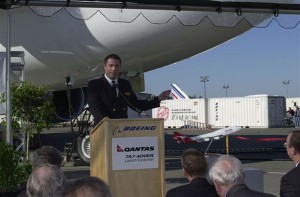
John Travolta continues as an ambassador-at-large for Qantas six years after cementing that partnership.
Travolta based the book’s main character, Jeff, on himself.
“I was the little boy, so it was my whole viewpoint, excitement and passion about aviation,” he said. “Other characters were composites. If I broke down the book for you, I could tell you who everybody was, every moment. For the female characters, some moments, it was my sister, Ellen, and some of it was my mother. Sometimes, it was a friend of my mother’s, and sometimes, it was a friend of my sister’s. The stewardess was a composite of different ladies I’d known over the years. The buddy was a composite of a couple of friends I had over the years.”
In the book’s epilogue, Jeff has grown up and is a captain for United Airlines on the New York to L.A. run. He’s also married Doris, the pretty stewardess he met on his magical flight. The decade and a half age difference isn’t a problem, especially since the couple shares their passion for flight.
Travolta’s life turned out a little differently than his main character’s. He didn’t need to be a captain for United to fly the jets they fly and he didn’t need to marry a flight attendant to be extremely happy. He and Kelly Preston have his “other passion” in common. She did consider learning to fly at one time.
“She was interested, but one day she saw me circumnavigate a storm,” he said. “I got us down safely. She thought, ‘I don’t really want to have to do that. I’ll just let you do it.'”
That seems to be the feeling shared by his children. He says his 7-year-old daughter, Ella Bleu, loves traveling, and Jett, his 15-year-old son, loves to fly, but neither has shown a specific interest in piloting.
In recent years, Travolta picked up the pen again, but this time he’s not writing fiction. He’s been working on his autobiography, which will be out next year. Presently, he’s about two-thirds of the way through it.
“A lot of life has happened since I stopped writing in the summer,” he said. “I did a movie with my family, and I had two big hits come out. There’s more to say; I just don’t like boring people with too much bric-a-brac, so I cut the fat out of my communications, and I try to get to the point.”
One of his summertime hits was “Wild Hogs,” an “action-packed comic drama about men, motorcycles and mid-life crises.” In the film, which earned more than $250 million in worldwide box office, he hits the road with fellow frustrated suburbanites Tim Allen, Martin Lawrence and William H. Macy. The other was “Hairspray,” an update of John Water’s hit musical. To play Edna Turnblad, the main character’s mother, Travolta donned a “fat suit” and suffered through more than four hours of makeup each day. The film’s cast included Michelle Pfeiffer, Christopher Walken and Queen Latifah, and found Travolta belting out ’50s-inspired tunes like “Big, Blonde and Beautiful.” It has since become the third-largest grossing musical in U.S. history.
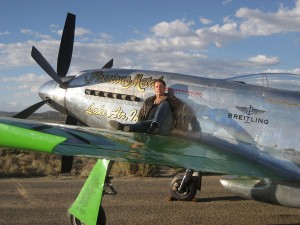
Breitling spokesman John Travolta relaxes on the wing of Precious Metal, a P-51D Mustang piloted by Ron Buccarelli during the 2007 Reno Air Races and Air Show.
The prolific actor re-teamed with “Wild Hogs” director David Becker to star in “Old Dogs,” another ensemble comedy set for release in 2008. The film costars Travolta’s longtime friend Robin Williams, as well as Bernie Mac, Matt Dillon, Kelly Preston and Ella Bleu Travolta.
Travolta lends his voice to the main character in Walt Disney’s “Bolt,” due out late next year. The film follows the adventures of a German shepherd who has lived his whole life on the set of his action TV show and believes he has superpowers, until his accidental separation from the studio. Travolta also voices an animated spaceman in “Quantum Quest: A Cassini Space Odyssey,” an upcoming science fiction film that is in production.
It’s not surprising that Travolta has chosen to be involved in a few science fiction projects. Space is a subject that captivates him. In July 2005, he participated in a 30th anniversary celebration of the Apollo-Soyuz Test Project, serving as host for the event gala. Travolta’s interest in space travel runs as deep as his admiration for astronauts.
“I do want to be in space and to go to other planets, but I’d have to break through the close spaces for long periods of time,” he said. “I think that would be interesting to adapt to; space travel fascinates me. I think we need to be in space. This planet may, in the next few hundred years, be in some sort of situation that needs help. We may need to develop the ability to live elsewhere, if we can find planets with atmospheres that are livable, just out of survival for the species here. I think interplanetary concepts are needed, out of necessity. I could see the day where we possibly burn off the ozone layer, so we’d need domed cities in the not too far distant future. And I think that discovering other planets’ life forms is important, just to know what our options are as a species.”
As he talks about the future of our planet, he also voices what he believes will be the next frontier on Earth.
“We’ve had a great opportunity with supersonic flight, and we missed the boat a little bit by not overcoming the noise problem associated with breaking the sound barrier,” he said. “Now, I think that hypersonic is the way to go—you leave L.A., are in Paris 30 minutes later and in Australia an hour later. Any faster than that doesn’t make sense. You might as well teleport yourself,” he laughs. “There’d be no reason to travel.”
Teleportation, instead of flying himself from one location to another, definitely doesn’t interest Travolta. Also, although hypersonic might be in the Earth’s future, he’d still like his “personal” turn at supersonic.
“I haven’t flown supersonic yet, other than the Concorde as a passenger,” he said. “I’d like to fly supersonic as a pilot. I almost bought a little supersonic plane.”
Inspiration
Travolta has been an inspiration to both would-be actors and pilots. As he reflects on his rich, full life, he ponders who has inspired him.
“Howard Hughes was an inspiration, because of his beautiful design of the Constellation and his passion for the airlines,” he said. “Lindbergh was an inspiration, and so was Chuck Yeager and the various astronauts, like John Glenn. Many of the old-timers have done such great work. The Boeing designers have inspired me, as have the French and English designers, whether for the Concorde or the Comet, or other beautiful aircraft over the years. Vern has really been an inspiration, as far as innovative design of his Eclipse.”
Travolta says that Geoff Dixon and Margaret Jackson may be at the top of his list. He admits that has a lot to do with his childhood fascination.
“I love airlines,” he says. “I’ve watched them run an airline the last five years, and they know how to do it. They’re so smart, passionate and innovative about what they’re doing. Qantas is also the first airline to donate airplanes at any natural disaster, and they always support charities of the humanities. They treat their employees well and are so concerned about their passengers’ comfort. Their safety record’s perfect.”
Going a step further, he says that the people responsible for his ambassadorship with Qantas have really been ambassadors to him and others.
“They’ve been fantastic representatives of my passion,” he said.











